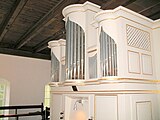Johann Dietrich Kuhlmann
 From Wikipedia - Reading time: 4 min
From Wikipedia - Reading time: 4 min
Johann Dietrich Kuhlmann (c. 1775 – 1846) was a German organ builder. As son-in-law and successor of Johann Stephan Heeren, he worked in Gottsbüren.
Life and career
[edit]Kuhlmann became acquainted with the family business of Johann Stephan Heeren as an employee. Together with him, he created the organ in Adelebsen around 1800. After the death of Heeren's son-in-law Johann Friedrich Euler in 1795, Kuhlmann married Heeren's daughter Anna Elisabeth. Heeren's son Johann Christoph worked in the workshop during the last years of his father's life and took over the workshop together with Kuhlmann in 1804.[1] As a result, the company now called itself "Heeren et Kuhlmann".[2] When Heeren's grandson Balthasar Conrad Euler joined the business around 1815, it was renamed "Euler and Kuhlmann". His son Georg Carl Kuhlmann also became an organ builder and can be traced in Westphalia with several new organ buildings.[3] Johann Dietrich Kuhlmann worked mainly in the Orgellandschaft Südniedersachsen. The family business was moved to Hofgeismar in 1910 and continued well into the 20th century. It is considered the oldest organ building company in Germany.[4]
Work
[edit]| Year | Location | Church | Picture | Manual | Stops | Notes |
|---|---|---|---|---|---|---|
| um 1800 | Adelebsen | St. Martini |  |
I/P | 13 | Together with Johann Stephan Heeren |
| 1813 | Vernawahlshausen | St.-Margarethenkirche | I/P | 12 | New construction or conversion using older housing parts.[5] | |
| 1816–1817 | Göttingen | Ev.-ref. Kirche | 
|
II/P | 15 | Originally built for Stöckheim (Northeim); transferred to Göttingen in 1860 by Giesecke and redisposed; 1913/14 new interior work by Furtwängler & Hammer with additional Brustwerk; 1969/70 new pipework by Paul Ott; upper part of the facade and one stop from 1817 preserved.[6] |
| 1818–1819 | Zennern | Michaeliskirche | I/P | 12 | Together with Euler; five stops and casing preserved.[7] | |
| vor 1820 | Hemeln | Ev.-luth. Kirche | II/P | 15 | Together with Euler; largely preserved.[8] | |
| ca. 1820 | Herlinghausen | Ev. Kirche | I/P | 10 | Kuhlmann and Euler are presumed to be the builders, but are not clearly documented.[9] | |
| 1824 | Bühren | St. Michaelis-Kirche | Completely preserved.[10] | |||
| 1824 | Erbsen | St. Vitus | 
|
I/P | 12 | Preserved |
| 1825 | Barterode | St. Pankratii |  |
I/P | 15 | Together with Euler.[11] |
| 1829 | Scheden | St.-Markus-Kirche | 
|
I/P | 15 | 1829 new construction using older material (parts of the supporting structure and a few stops), 1860 reconstruction by Giesecke and 1899 by Furtwängler & Hammer, 1937 restoration to baroque conception by Ott and extension of the single-manual organ by a Rückpositiv (II/P/22), 2011 restoration.[12] |
| 1840 | Bad Fredeburg | St.-Georgkirche | II/P | Moved to new church without alterations in 1932; extensively rebuilt by Anton Feith in 1943 (35 stops); 15 stops preserved by Kuhlmann.[13] | ||
| 1844 | Hohenwepel | St. Margaretha | Replaced by new building by Anton Feith in 1927 |
References
[edit]- ^ Eckhard Trinkaus; Gerhard Aumüller (1997). Friedhelm Brusniak; Hartmut Wecker (eds.). Organ building in the district of Waldeck-Frankenberg. Korbach: Bing. p. 190. ISBN 3-87077-098-8.
{{cite book}}:|work=ignored (help) - ^ Eckhard Trinkaus (1981). Organs and Organ Builders in the Former County of Ziegenhain (Hesse). Marburg: Elwert. p. 332. ISBN 3-7708-0713-8.
- ^ Fritz Schild: Denkmal-Orgeln. Dokumentation der Restaurierung durch Orgelbau Führer 1974-1991. Florian Noetzel, Wilhelmshaven 2005, ISBN 978-3-7959-0862-1, p. 623.
- ^ Hans Römhild (1967). Deutschlands ältestes Orgelbau-Unternehmen. Vol. 17. pp. 110–116.
{{cite book}}:|work=ignored (help) - ^ Orgel in Vernawahlshausen, retrieved 22 February 2021.
- ^ Eike Dietert; Ev.-Ref. Gemeinde (ed.): Zur Geschichte der Orgeln in der Evangelisch-Reformierten Kirche zu Göttingen. Göttingen 1999.
- ^ Orgel in Zennern Archived 2016-02-07 at the Wayback Machine; retrieved 22 February 2021.
- ^ Orgel in Hemeln, retrieved 22 February 2021.
- ^ Orgeln in Warburg, retrieved 22 February 2021; Abb. unter Die Orgel aus der Kirche in Herlinghausen, retrieved 22 February 2021.
- ^ Orgel in Bühren, retrieved 22 February 2021.
- ^ Orgel in Barterode, retrieved 22 February 2021.
- ^ Orgel in Scheden Archived 2018-04-18 at the Wayback Machine, retrieved 22 February 2021.
- ^ Orgel in Bad Fredeburg, retrieved 22 February 2021.
Further reading
[edit]- Dieter Großmann (1998). Orgeln und Orgelbauer in Hessen (2. ed.). Marburg: Trautvetter & Fischer. ISBN 3-87822-109-6.
- Hans Römhild (1967). Deutschlands ältestes Orgelbau-Unternehmen. Vol. 17. pp. 110–116.
{{cite book}}:|work=ignored (help) - Eckhard Trinkaus; Gerhard Aumüller [in German] (1997). Friedhelm Brusniak, Hartmut Wecker (ed.). Orgelbau im Landkreis Waldeck-Frankenberg. Korbach: Bing. pp. 144–202. ISBN 3-87077-098-8.
{{cite book}}:|work=ignored (help) - Eckhard Trinkaus (1981). Orgeln und Orgelbauer im früheren Kreis Ziegenhain (Hessen). Marburg: Elwert. ISBN 3-7708-0713-8.
 KSF
KSF